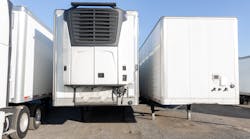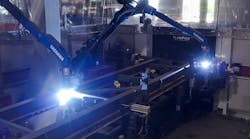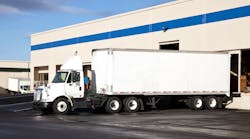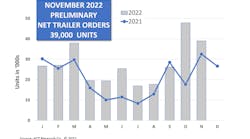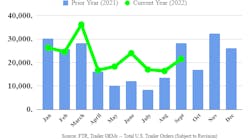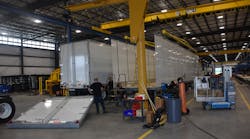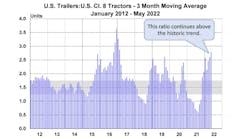IT WAS A GREAT YEAR for building truck trailers. In the calendar year 2006, most trailer manufacturers stepped up production somewhat even though bumping against capacity limits — and a few increased output greatly. The total production for the 30 largest manufacturers was 278,000 truck trailers, a 13% increase over 245,000 trailers these same 30 manufacturers built in 2005.
The first half of the year was especially good, even though rising material and component prices were still a concern, and many customers were more worried about their truck tractor fleets and the new engine regulations. Falling freight volumes slowed ordering during the final months of 2006, and that is affecting the 2007 outlook. But all said, it was a record-setting year for the industry and for many individual trailer manufacturers.
Great Dane and Wabash finished in a virtual tie as North America's largest trailer manufacturer. Only 400 trailers separated these two companies after 2006 production was counted. At their level of production, that is a mere 0.6% difference. And while Great Dane produced 400 more trailers, Wabash turned out 700 domestic containers and 1,400 dollies last year — products that Great Dane does not manufacture.
If we look strictly at production of complete trailers, the seven largest manufacturers are in the same order as last year — Great Dane, Wabash National, Utility, Stoughton, Hyundai Translead, Fontaine, and Trailmobile Canada. Beyond that, practically every company has changed places this year, primarily because 11th ranked Vanguard National jumped to 8th position as a result of a 65% increase in van trailers produced, and the company says it is aiming for 6th position in 2007.
On the lower end of the scale, fast-rising Reitnouer Inc jumped from 19th to 15th position, and 28th ranked Benson International jumped to 23rd after adding a new, automated factory and almost doubling the number of trailers produced.
The top 10 manufacturers built 229,738 trailers, which is about 83% of the total for all 30 manufacturers. The next 20 ranked manufacturers built the other 17% of the trailers counted in this survey.
This list of United States manufacturers also includes two Canadian plants, Trailmobile Canada and Manac, and one Mexican factory, Hyundai Translead, because all three direct a large part of their sales at the U S market. Therefore, the totals from these 30 manufacturers cannot be compared directly with reports of trailer production from solely U S plants.
The total of the 27 U S only companies is about 248,000 trailers, which compares favorably with other surveys that state that all trailer manufacturers in the U S built over 257,000 trailers in 2006.
This Trailer/Body Builders survey is made by telephoning a member of the management team at each trailer manufacturing company. The survey is built on the voluntary contribution of trailer production information at each company. An estimate is made for the company that chose not to participate. The survey is the work of Trailer/Body Builders and should not be confused with any other survey.
-
Great Dane Limited Partnership built 60,300 complete trailers in its nine manufacturing plants, according to Brandie Fuller, Great Dane's director of advertising and industry relations. This is a 10% increase over its production in 2005. The company manufactures dry-freight and refrigerated vans, along with platform trailers. Specific production numbers for each category of trailer were unavailable. Traditionally, however, Great Dane has been the second largest manufacturer of refrigerated vans.
-
Wabash National Corporation increased production of dry vans by 2%, building 47,500 vans, while refrigerated trailers were up 13% to 5,600 reefers. Not counting the 700 domestic containers and 1,400 dollies, this brings the count of Wabash complete trailers to 53,100. Since Transcraft Corp was purchased on March 3, 2006, its production of platforms should be added in, and it brings the total count of complete trailers to 59,900 for Wabash National. Transcraft's production of 6,809 platforms in 2006 was a 21% increase above the 2005 level, and would have made Transcraft the ninth largest trailer manufacturer if its production had been counted separately.
Richard Giromini, CEO of Wabash National, says they expect the economy to grow in 2007, but at a slower pace. They also expect carriers to focus on upgrading their trailer fleets, on understanding their maintenance costs, and how to reduce them with increased trailer durability. He says that the fact that other trailer manufacturers are introducing composite dry van trailers tends to validate the significant effect that Wabash National's Duraplate trailers have had on the industry for the past 10 years.
-
Utility Trailer Manufacturing had a great year, building more trailers than ever before — 36,636 of them, a 6.7% increase. All three product lines showed increases: 18,993 refrigerated trailers, up 10.4%; 13,776 dry vans, up 2.5%; and 3,867 platforms and curtainsiders, up 4.75%
Utility remains the largest manufacturer of refrigerated trailers in the world, building almost half of the U S total. That increase was helped by a 90,000 sq ft addition to the Virginia reefer plant that came on-stream at mid-year. These refrigerated trailers were all essentially the Utility Model 3000R that was introduced in 1999 and has led to increased company sales ever since.
The current 2007 year will be more challenging, according to Craig Bennett, senior VP sales & marketing. Because it is the fourth year in a boom cycle and costs are still going up, he sees the industry totals staying equal or a little down. He says Utility plans to be equal or a little up, building a few more trailers in 2007. Orders were a little slow in December and January, but not down dramatically. He thinks the year may start slow, but will finish strong.
-
Stoughton Trailers increased production of it dry freight vans by 11% in 2006, reaching a new high of 18,900 total trailers. However, orders dropped off dramatically in November after freight volumes declined in the face of rising employment, leaving a lot of indecision about the market trend. CEO Don Wahlin says they have a lot of quotes out waiting for orders.
The intermodal market is another story. Wahlin says the intermodal business is dead and buried. It will not come back. It has gone to China. Stoughton built 1,200 container chassis early in the year, along with 320 domestic containers, but ran out of orders at mid-year. The Stoughton intermodal plant is now shut down except for van trailer overflow production from its other plants.
-
Hyundai Translead had a 26% increase in van trailer production, reaching 14,498 vans, which includes 746 refrigerated trailers, also up 26%. Domestic container production was up 54% at 4,995 boxes, and container chassis were down 30% at 10,792 chassis. The company also built 468 converter dollies, about the same number as in 2005.
This was the fifth year in a row that van trailer production has increased at Hyundai Translead. It was made easier by the addition in April 2006 of another line at its plant in Tijuana, Mexico, adding capacity for another 500 containers or trailers per month.
-
Fontaine Trailer Company boosted trailer production 30% after a 15% increase in 2005. Steel and aluminum platforms were up 27% at 9,651, and lowbed production increased 58% to 1,390 trailers. This brought the total to 11,041 trailers.
The dramatic increase in production was made possible by a new plant in Jasper, Alabama, that came on line in April 2006. It is dedicated to fleet orders, thus freeing up space in the Haleyville, Alabama, plant for more dealer orders.
-
Trailmobile Canada Limited squeezed out a few hundred more van trailers from its at-capacity plant in Mississauga, Ontario. This amounted to a 2% gain to 8,400 trailers. Even though trailer orders have slowed, Tom Wiseman, president of T/M Canada, thinks that 2007 could be comparable to 2006 if the economy picks up and we have a strong second half of the year.
-
Vanguard National sales were up more than 65% to 8,113 dry freight vans, just above the 8,000 mark predicted a year ago, and after a 70% increase the year before. Vanguard introduced its new composite plate van trailer in March, and produced 1,523 of this new model in less than a year. The steel-skin composite plates are made in China, as are many of the welded and galvanized subassemblies for Vanguard trailers. Robert Taylor, director of sales, predicts another good year in 2007, with the company ramping up to a predicted 13,000 vans.
-
Transcraft Corporation would have been ranked in ninth place, but now its 6,809 platforms are part of the 59,900 trailers reported by its parent company, Wabash National Corp.
-
Manac increased production 3% to 6,800 trailers, including all three plants in Missouri and Quebec. Charles Dutil, president, says they are expecting a flat year in 2007. While capital spending will be less, he thinks fleets will be focusing more attention on trailer equipment and less on the truck tractors. Manac is widely diversified, offering truck trailers ranging from dry freight vans and platforms to logging, lowbeds, dump trailers, and moving floor waste haulers.
-
Strick Corporation was still at capacity in its Monroe, Indiana, plant, running two 10-hour shifts four days a week, but the unit numbers were down 14.5% to 5,150 dry freight vans. This is attributed to building a lot of long trailers with more options, requiring a higher labor content.
Strick's sister company building Cheetah container chassis in Berwick, Pennsylvania, likewise had a good revenue year, but was way down in unit numbers. The company built 5,900 Cheetah chassis in a very soft intermodal market, down 26% from 2005. Strick's rail, steamship, leasing, and drayage customers are looking for the soft freight market to continue. Murray Zwickel, VP sales & marketing, says the future for their company will be in building very specialized container chassis, since the Chinese are taking most of the orders for standard 20-ft and 40-ft container chassis.
-
Heil Trailer International had another record year, building nearly 4,500 trailers company-wide. This was a 12.5% increase over 2005. The majority of the increase came from the U S commercial tank trailer market, where Heil realized a 25% increase in unit sales, according to Bill Harris, marketing manager.
-
Road Systems has gained a 45% increase each year for the past two years. Aside from these back-to-back gains, it has established itself as a manufacturer of new trailers in addition to its refurbishing work. Of the total 4,491 van trailers completed in 2006, 2,849 were new and 1,642 were rebuilds; 1,350 were long semi-trailers and 3,141 were short doubles trailers. In its converter dolly line, 300 were new and 243 were rebuilds, for a total of 543.
Most of these production figures exceed slightly the forecast General Manager Lynn Reinbolt made a year ago. However, 2007 is starting as a different sort of year with a lot more unknowns, so there is no clear forecast.
-
Trail King Industries built exactly 3,800 truck trailers (excluding those tag trailers with under 10,000-lb capacity axles). This was an 8% gain over 2005. The majority of these were heavy-haul and step-deck trailers (2,545), followed by 898 dump trailers and live floor trailers, plus 327 pneumatic dry bulk tanks and 30 chassis.
These gains were made possible by expanding the Brookfield, Pennsylvania, dump trailer and pneumatic tank plant in July, and doubling the size of the Fargo, North Dakota, plant for live bottom trailers at mid-year.
The backlog for 2007 still remains strong in Trail King's major markets, especially for heavy-haul equipment. Chuck Noel, VP administration, says the other markets are a little soft, but they still think 2007 will be a very good year.
-
Reitnouer Inc in Reading, Pennsylvania, increased production 45% in 2006, after a 53% increase in 2005. Production peaked at 85 trailers a week in September, October, and November, and dealers were on allocation. The final tally was 3,738 aluminum platforms and drop-decks, including a few platform tippers and live floor trailers. Now with steel production down and housing off, the demand has slackened. Bud Reitnouer believes that 2007 will be down, but his production could still be in the range of 3,000 trailers in 2007.
-
Lufkin Trailers' production was down 5% in 2006 to 3,331 units, chiefly because of a 25% drop in the number of van trailers, down from 2,108 vans in 2005 to 1,579 vans in 2006. All other product lines showed increases. Platforms and floats were up 20% to 1,465 units, and dump trailers were up 59% to 275 units, plus 12 lowboys, according to Joe Burch, new trailer sales manager, Lufkin, Texas.
-
Timpte Inc in David City, Nebraska, had an all-time record year in 2006, producing 3,090 bulk commodity trailers. However, it was a disappointing year in terms of lost margins. CEO Ken Allred says they increased prices through the year, but could never catch up with the material and component cost increases.
Demand for ag and bulk commodity trailers remains high, with more corn and soybeans going to ethanol and plastics plants, so Allred is forecasting about the same number of trailers will be built in 2007 or maybe a little more. However, net margins won't improved much, since aluminum prices are bumping up again.
-
East Manufacturing Company in Randolph, Ohio, was up 10% in 2006. It produced 2,740 aluminum trailers, plus an additional 210 aluminum dump bodies. East has just completed a 50,000-sq-ft addition to its plant, bringing total space to 470,000 sq ft for manufacturing aluminum platforms, dumps, and refuse trailers. With a soft fourth quarter in 2006 and soft first quarter in 2007, Dave Tate, president, thinks 2007 production will be off about 10% — hopefully not more. Aluminum prices remain a concern that keeps margins below expectations.
-
MAC Trailer Manufacturing built 2,574 aluminum platform, dump, and refuse trailers in 2006, a 19% increase, plus 146 dump bodies for a 2,720 total unit count. Mike Conny, president, says orders dipped in November and December, but picked up in January, so now the company has a solid 90-day backlog. The company is planning to build 3,500 to 4,000 trailers in 2007, concentrating on platforms. MAC Trailer has added 200,000 sq ft to its manufacturing plant in Alliance, Ohio, for expansion of the platform line, and it is introducing a new all-aluminum drop-deck with a heat-treated neck.
-
Polar Tank Trailer in Holdingford, Minnesota, had anticipated a 15% increase in its tank trailer and pneumatic dry bulker production in 2006, yet managed to produce 32% more trailers than the year before. The final count was 2,344 stainless steel, carbon steel, and aluminum tank and dry bulk trailers. Polar was pretty much at capacity all year, and is almost booked up for 2007, requiring adding on to one facility. John Koll, VP sales and marketing, is projecting a 20% increase in 2007. The biggest gains will be in petroleum type tankers, as well as smaller increases in dry bulkers.
-
Kentucky Trailer in Louisville was down 18% in trailers produced, turning out 2,122 van trailers. Larry Hartog, president, says Kentucky's traditional furniture van production was down about 10%, and 2006 proved to be an off-year in the buying cycle for its customers that need large-capacity, step-deck van trailers. He thinks customers are pausing to read the tea leaves, but 2007 could be comparable to 2006 if the economy turns up again soon.
-
Pitts Trailers in Pittsview, Alabama, posted a small 2% gain to 1,945 complete trailers. Business has been good and holding steady, says Jeff Pitts, in spite of a dip in the forestry industry. The company makes logging trailers, lowbeds, and specialty trailers.
-
Benson International, recorded the biggest percentage increase in trailer production numbers, almost doubling its output of platforms and dump trailers. It built 1,506 platform trailers and 427 dump trailers for a 1,933 total, up 98% from 2005. Benson also produced 607 dump bodies for trucks, and 104 stake bodies, for a total production of 2,644 units. And it produced most of these before its new, automated plant in Cadiz, Kentucky, was fully on line. This fourth manufacturing plant in Cadiz is also the site for Benson headquarters, which has moved from Mineral Wells, West Virginia.
-
Talbert Manufacturing, Rensselaer, Indiana, increased trailer production numbers by 26% in 2006, building 1,266 units. This includes 819 commercial lowbeds and 447 flatbeds on a government contract. Talbert is looking for a slight increase in 2007, especially in flatbed production. To this end, Andy Grylls has joined the company as sales manager.
-
Beall Corporation in Portland, Oregon, built 1,219 trailers in 2006, a 15% increase. Beall also built 286 truck bodies used in truck-and-full-trailer combinations, for a total of 1,505 units. The strength of the market going forward is best expressed by the fact that Beall is quoting tanks and pneumatics for delivery in 2008, and bottom dumps for November 2007.
To handle the increased demand, Beall has purchased another plant in Sunnyside, Washington, and will move bottom dump production there. This will free up the Billings, Montana, plant for more petroleum tank production. The company also has manufacturing plants in Portland and Salem, Oregon, and Turlock, California.
-
Kidron Inc increased production 20% in 2006, turning out 1,187 refrigerated trailers for multi-stop distribution. These are mostly in the 27- to 42-ft length, but also includes a few 53-ft trailers for customers making pick-ups of inbound freight after a distribution run. John Sommer, executive vice-president, sees a solid market in 2007 for these refrigerated distribution trailers. Kidron has four manufacturing locations: Kidron, Ohio; Lakeland, Florida; Montgomery, Pennsylvania; and Tulare, California.
-
Western Trailer in Boise, Idaho, built 1,140 trailers, a 17% increase. Over 800 of these were platforms, but it also included ag trailers, bulk hoppers, moving floor trailers, and platform tipper trailers. The outlook for 2007 is fewer platforms and more bulk commodity trailers.
-
Brenner Tank LLC in Fond du Lac, Wisconsin, increased its unit numbers 16% to 1,050 tank trailers, but manufacturing labor hours increased 20% to 30% because of the specialized nature of the tanks. The market remains robust especially for aluminum petroleum tank and specialized bio-fuels. However, the market for chemical tanks is being hindered by the high cost of stainless steel. John Cannon, VP sales and marketing at Brenner, says the cost of a DOT 407 chemical tank trailer has increased 100% in the last four years.
-
Travis Trailer Company in Houston, Texas, built 14% more trailers in 2006 for a total of 912 primarily dump trailers, but also moving floor transfer trailers and bottom dumps. Travis was limited by capacity in 2006, so the forecast is for about the same number of trailers in 2007, or only a little better given the high demand, says C K (Bud) Hughes, president.
-
Clement Industries in Minden, Louisiana, had a record sales year. The number of trailers built increased 6% to 872, but the dollar volume and margin increased far more because of the many scrap and demolition trailers built, which require far more material and labor hours, according to Bill Garrison, VP sales.
Tank trailer sales reach $840 million in 2006
The fabrication of 11,400 tank trailer units in 2006 produced sales of $840 million in the United States, Mexico, and Canada, according to a report by SpecialtyVehicles.net (SVN).
Among tank trailer manufacturers in the report are: Acro Trailer Co, Advanced Engineered Products Ltd, Beall Corp, Bedard Tankers Inc, Brenner Tank LLC, Bulk Manufacturing of Florida, City Machine and Welding, Comptank Corp, Dragon Products Ltd, E D Etnyre and Co, FIBA Technologies, Fort Worth Fabrication, Galyean Equipment Co, Gator Tank, Heil Trailer International, Hutchinson Industries, LBT Inc, Mississippi Tank Co, Paramount Tank Inc, Polar Corp, Robica-Forman Tank Ltd, SemoTank/Baker Equipment Co, Stephens Pneumatics Inc, Tankcon FRP, Inc, Texas Trailer Corp, Thompson Tank Inc, Trail King Industries, Trans-Tech Industries Inc, Tremcar Inc, Tri State LLC, Troxell Trailer Manufacturing LLC, Vantage Trailer Inc, Walker Transportation, and West-Mor Industries LLC.
The data also contains the number of trucks and trailers in use for the Top 20 fleets as reported in the Bulk Transporter 2005 annual Gross Revenue Report.
Some of the findings contained in the SVN report are:
-
Annual production for all types of tank trailers was estimated at just over $800 million.
-
Specialization is a key aspect of tank trailer manufacturing operations. Smaller players tend to focus on narrow niches, while larger manufacturers have the ability to cross over from their principal product lines.
-
The fragmented nature of the industry, occupied by relatively small private companies, provides for a typical backdrop for private equity buyouts. Consolidations can be expected accordingly.
The 109-page report is available as a complete study titled Tank Trailer Manufacturing in North America: Size, Growth, Trends, Channels, and Competition Underlying the Manufacture of Tanker Trailers by Application Type(s) in North America or by individual sections for each of five segments. Company profiles are also available for purchase separately. Further information is available at www.specialtyvehicles.net or phone 209-576-8021.
Canadian manufacturers post gains
The two largest Canadian manufacturers of truck trailers are included on the list of Top 30 Trailer Manufacturers because a large share of their production is marketed in the United States.
Trailmobile Canada Ltd in Mississauga, Ontario, is seventh ranked with 2006 production of 8,400 dry freight vans.
Manac in St Georges, Quebec, is ninth ranked with production of 6,800 trailers representing a widely diversified line.
Three other manufacturers in the central plains and western part of Canada should also be included because their production is above the 1,000 level.
Doepker Industries Ltd in Annaheim, Saskatchewan, produced 1,800 truck trailers in 2006, a 28% improvement over the 1,400 produced in 2005. The company plans to build even more trailers in 2007. With favorable market conditions continuing, the goal for this year is another 15% increase to the 2,100 level, according to Mara Doepker, marketing manager, located at the Humboldt branch.
Besides the main manufacturing plant in Annaheim, Doepker has four branch locations in Moose Jaw, Humboldt, and Saskatoon, Saskatchewan, and in Salmon Arm, British Columbia. Dealers are located throughout the four western provinces. The product line includes agricultural and bulk hoppers, platforms, curtainsiders, end dumps, logging trailers, oilfield floats, and detachable gooseneck lowbeds.
Lode King Industries in Winkler, southern Manitoba, is midway between the east and west coasts and only 15 miles north of the North Dakota border. It claims to be central Canada's largest manufacturer of flatbed and grain trailers. It has dealers all across Canada coast to coast. Annual production is estimated to be over 1,500 truck trailers.
Advance Engineered Products Ltd in Regina, Saskatchewan, claims to be Canada's leading tank truck and tank trailer manufacturer, including pneumatic bulkers, as well as logging and grain trailers. Besides the main manufacturing plant in Regina, specialized products are produced in the company's eight branch locations that are equipped for service and repair of cargo tank vehicles. Annual production is estimated to be over 1,000 trailers.
